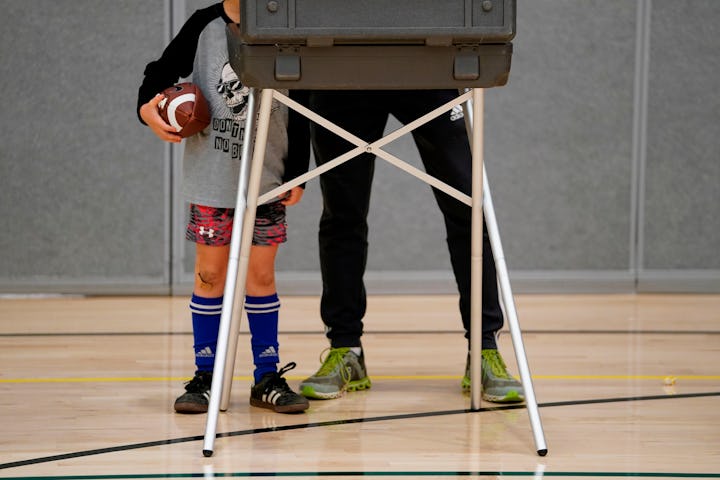Yes, You Can Take Kids To Vote And Get “I Voted” Stickers. It’s An American Right
In every state in the USA, parents can take their kids with them to polling locations, and in most cases, even inside of the booth.

Good news, parents: In every state, it’s legal to bring children to the polls to vote (and also adults if they’re registered). Kids can even come into the booth. So, if you’re trying to figure out how to vote today — and worried about child care — you certainly don’t need to be. Still, there are caveats that make voting with kids both a little bit trickier than advertised, and potentially far more fulfilling.
Although all 50 states allow kids to join their parents at the polling location, there are different rules and restrictions in different states. While all states allow minors to come to the voting place with you, in some states, that definition of what a minor is varies. The election commission in Connecticut defines a minor as someone 15 years or under, while every other state defines a minor as someone 17 or under. Other laws in place in Maryland or Pennsylvania limits on how many children can come into the booth, capping that number at two and one children per voting booth, respectively. (Rules aside, photos are still illegal.)
The best part of the process is that you can legally allow your child to vote. After all, your choice is finalized and tallied after your ballot is processed by a voting machine. Who operates the voting machines? Voters, who can either pull the lever or press the button.
Laws dictate that children are also allowed to pull levers and press buttons, meaning that they can very literally cast ballots. Your kid can leave a polling place claiming to have voted and not be… entirely wrong. The best part? Poll workers are pretty good about handing out stickers after the fact. Kids getting an adhesive badge of honor they can wear proudly, knowing that their family participates in representative democracy.
On the way to the polling place, parents should take care to explain who they are voting for and why. Without suggesting that kids should have the same belief systems as them, parents have an opportunity to explain their worldviews. It’s clear that kids of parents who are politically involved (and vocally so) tend to be more political themselves — the research is clear on that — and a 2016 study in Political Research Quarterly showed that whether or not parents vote tends to determine whether or not their kids will later on, regardless of their political views or policy opinions. Having kids be witness to the process of voting is a part of behavior modeling.
Also, children are really smart. Although they may not understand complex policy decisions, income taxes, or the mechanics of a midterm ballot initiative, they absolutely do understand cause and effect. In the simplest of terms, explaining a vote as a cause — and the result of that vote as the effect — can help kids understand that elections have consequences, and they are decisions that are made in a larger context, one that creates results, even if it’s in the simplest of terms.
The opportunity to talk about democracy and then show it to children in person makes every election day extremely exciting for politically engaged parents. Still, democracy is all about rules and parents must be mindful of kids. Children may not interfere or disrupt the voting process. Laws say so and common decency says so as well. Still, that’s a high bar. It’s probably fine if they disrupt the voting process just a little. After all, it’s their process too — part of a national inheritance worthy of celebration.
This article was originally published on